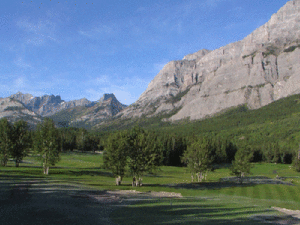Alberta: Difference between revisions
imported>Derek Hodges (grammar) |
imported>Michael Geldorp m (bolding page title) |
||
| Line 3: | Line 3: | ||
[[Image:Kananaskis.gif|right|thumb|300px|{{#ifexist:Template:Kananaskis.gif/credit|{{Kananaskis.gif/credit}}<br/>|}}Kananaskis Country, Alberta.<br><small>Photo credit: Michael Nishizaki</small>]] | [[Image:Kananaskis.gif|right|thumb|300px|{{#ifexist:Template:Kananaskis.gif/credit|{{Kananaskis.gif/credit}}<br/>|}}Kananaskis Country, Alberta.<br><small>Photo credit: Michael Nishizaki</small>]] | ||
Alberta is one of the western provinces of [[Canada]]. Established in 1905, it is located to the north of [[Montana]] between the provinces of [[British Columbia]] and [[Saskatchewan]]. A majority of its population (3,455,062, 2007 est.) live in one of Alberta's two major cities, [[Calgary]] and [[Edmonton]]. | '''Alberta''' is one of the western provinces of [[Canada]]. Established in 1905, it is located to the north of [[Montana]] between the provinces of [[British Columbia]] and [[Saskatchewan]]. A majority of its population (3,455,062, 2007 est.) live in one of Alberta's two major cities, [[Calgary]] and [[Edmonton]]. | ||
==History== | ==History== | ||
Revision as of 08:03, 29 May 2008
Alberta is one of the western provinces of Canada. Established in 1905, it is located to the north of Montana between the provinces of British Columbia and Saskatchewan. A majority of its population (3,455,062, 2007 est.) live in one of Alberta's two major cities, Calgary and Edmonton.
History
Calgary hosted the 1988 Winter Olympics.
Geography
Alberta is one of Canada's Prairie Provinces, bounded on the west by the Rocky Mountains. Banff National Park is located in this region and remains Canada's oldest national park.
Government
Provincial politics in Alberta has traditionally been dominated by the ruling Conservative party. Current premier Ed Stelmach assumed office in late 2006.
Oil and gas
Alberta has long been Canada's principal producer of oil and gas, sparked by the Leduc Oil Field discovery. Alberta rich oil fields are part of the vaster Western Canadian Sedimentary Basin, stretching from British Columbia to Manitoba, as well as parts of Montana and North Dakota. [1]
With conventional reserves dwindling, development has shifted to the Athabasca Oil Sands, one of the world's largest oil reserves.
References
- ↑ Oil Sands in Saskatchewan (PDF). Saskatchewan Industry and Resources, Government of Saskatchewan. Retrieved on 2008-02-06.
